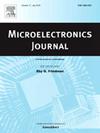A digital background calibration method for SAR ADC based on dual-layer feedforward neural network
IF 1.9
3区 工程技术
Q3 ENGINEERING, ELECTRICAL & ELECTRONIC
引用次数: 0
Abstract
This paper addresses the impact of capacitor mismatch, comparator offset, and incomplete settling of the digital-to-analog converter (DAC) on the dynamic performance of Successive Approximation Register (SAR) Analog-to-Digital Converters (ADCs). A digital background calibration method using a double-layer feedforward neural network is proposed. The network is trained in MATLAB and implemented on an FPGA to validate the calibration algorithm. The study explores the influence of parameters like the number of neurons, training samples, and iterations on performance. FPGA results show that, after calibration, the Spurious-Free Dynamic Range (SFDR) and Signal-to-Noise-and-Distortion Ratio (SNDR) of a 12-bit 100 MSPS SAR ADC model improved from 46.58 dB and 46.53 dB to 98.10 dB and 70.87 dB. Similarly, for a 10-bit 31.25 MSPS SAR ADC chip, SFDR and SNDR increased from 61.46 dB and 46.86 dB to 79.87 dB and 57.09 dB. These results confirm the proposed method’s effectiveness for addressing non-idealities in both simulated models and hardware.
基于双层前馈神经网络的SAR ADC数字背景标定方法
本文讨论了电容失配、比较器偏移和数模转换器(DAC)不完全沉降对连续逼近寄存器(SAR)模数转换器(adc)动态性能的影响。提出了一种基于双层前馈神经网络的数字背景标定方法。在MATLAB中对网络进行了训练,并在FPGA上实现了网络的标定算法。该研究探讨了神经元数量、训练样本和迭代等参数对性能的影响。FPGA结果表明,经过校准后,12位100 MSPS SAR ADC模型的无杂散动态范围(SFDR)和信噪比(SNDR)从46.58 dB和46.53 dB提高到98.10 dB和70.87 dB。同样,对于10位31.25 MSPS SAR ADC芯片,SFDR和SNDR从61.46 dB和46.86 dB增加到79.87 dB和57.09 dB。这些结果证实了该方法在处理仿真模型和硬件中的非理想性方面的有效性。
本文章由计算机程序翻译,如有差异,请以英文原文为准。
求助全文
约1分钟内获得全文
求助全文
来源期刊

Microelectronics Journal
工程技术-工程:电子与电气
CiteScore
4.00
自引率
27.30%
发文量
222
审稿时长
43 days
期刊介绍:
Published since 1969, the Microelectronics Journal is an international forum for the dissemination of research and applications of microelectronic systems, circuits, and emerging technologies. Papers published in the Microelectronics Journal have undergone peer review to ensure originality, relevance, and timeliness. The journal thus provides a worldwide, regular, and comprehensive update on microelectronic circuits and systems.
The Microelectronics Journal invites papers describing significant research and applications in all of the areas listed below. Comprehensive review/survey papers covering recent developments will also be considered. The Microelectronics Journal covers circuits and systems. This topic includes but is not limited to: Analog, digital, mixed, and RF circuits and related design methodologies; Logic, architectural, and system level synthesis; Testing, design for testability, built-in self-test; Area, power, and thermal analysis and design; Mixed-domain simulation and design; Embedded systems; Non-von Neumann computing and related technologies and circuits; Design and test of high complexity systems integration; SoC, NoC, SIP, and NIP design and test; 3-D integration design and analysis; Emerging device technologies and circuits, such as FinFETs, SETs, spintronics, SFQ, MTJ, etc.
Application aspects such as signal and image processing including circuits for cryptography, sensors, and actuators including sensor networks, reliability and quality issues, and economic models are also welcome.
 求助内容:
求助内容: 应助结果提醒方式:
应助结果提醒方式:


